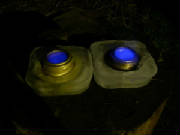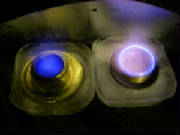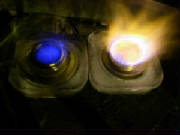|
One of the common misconceptions is that Alcohol stoves don't work well in cold weather. So I took a Trangia burner and
a SVEA burner, both full of fuel, and froze them in ice. Left them in my freezer at 0*F for 2 days. The fuel used was SLX-brand
denatured alcohol. I would expect Yellow-bottle Heet to perform better.
I had to touch the match to the fuel to get it to light. The commercial Trangia lit fairly easily. The Military SVEA
was much harder. Note that the Trangia was filled closed to the top than the SVEA and that might have made the "touch method"
work better.

|
| 1 minute after lighting |
After 5 minutes it was pretty clear that the commercial Trangia was usable. It was running at about 50% of full output.
The Military SVEA was taking a long time to heat the fuel.

|
| 5 minutes after lighting |
I let both burners run 10 minutes to see if the Military SVEA would get going enough to be usable. And it just barely
did. On the other hand the commercial Trangia was running at near full output.

|
| 10 minutes after lighting |
Lessons learned? Like much Swedish Military equipment, it hasn't been used. It is in good shape but it also isn't refined
by real field experience.
This test I setup isn't very realistic, after all - who is going to try to make breakfast with their stove frozen in
a block of ice. But this little demo does show the ruggedness and simplicity of an alcohol stove. And it helped me realize
why the Swedish Military cooksets are so cheap.
Before somebody talks you into buying and expensive, noisy, stinky, heavy white gas stove, realistically consider your
camping style and you will likely find that the Trangia-based alcohol stove will fit your needs.
|